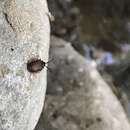en
names in breadcrumbs


Female water penny beetles lay their eggs above or at the edge of the stream or shore habitat where their larvae will live. Aquatic larvae hatch from the eggs and drop or crawl into the water. They cling to gravel and other hard debris in the water, grazing on the algae and other micro-organisms that grow there. In this stage they grow and molt several times during warm months. If the warm season is short, they may need more than one year to complete the larval stage. When read to transform, larvae small chamber where they enter the pupal stage and metamorphose into an adult. Some species create an air-filled chamber under water, but most pupate on land, in moist soil. Pupation is completed inside the larval skin. Adults don't live long.
Development - Life Cycle: metamorphosis
This small family of beetles gets its common name ("water pennies") from the unusual shape of the larvae, which have widely expanded dorsal plates that give the animals a flat round shape, like a coin. The classification of the family is uncertain, some authorities recognize some subgroups as separate families. There are only about 263 species in 31 genera are known (Lee et alia, 2007) but this family has not received intensive study, and there are probably more species still undescribed.
Water penny larvae feed on periphyton, the thin layer of algae and micro-organisms that forms on stones and other objects in moving freshwater. Adults may not feed.
Primary Diet: herbivore
Members of the Psephenidae are found on all continents except Antarctica.
Biogeographic Regions: nearctic (Native ); palearctic (Native ); oriental (Native ); ethiopian (Native ); neotropical (Native ); australian (Native )
Other Geographic Terms: cosmopolitan
Psephenid larvae cling to hard substrates (rocks, woody debris) in well-oxygenated water. They are most often found in fast-moving streams, especially riffle beds, but some species are found on rocky lake shores with wave action. Most pupae and all adults are air-breathing, but stay near the water. Adults are often found on the underside of logs and other objects overhanging streams.
Habitat Regions: temperate ; terrestrial ; freshwater
Aquatic Biomes: benthic ; rivers and streams; coastal
Other Habitat Features: riparian
Larvae are 3-10 mm long, ranging in color from pale amber to nearly black (usually matching the substrate) and have a distinctive shape. They dorso-ventrally flattened, with expansions of the dorsal plates that extend out so far that they are oblong or nearly round when viewed from above -- the head and legs completely covered. This flat round shape, plus their brownish color, earns them the name "water pennies". Larvae have clawed legs for clinging to rocks in moving water, and chewing mouthparts for scraping food off of rock and other hard substrate.
Adults are dark-colored, 4-6 mm long, with somewhat flattened bodies, short thread-like antennae, and mandibles not visible from above.
Most species in this family have amphipneustic larvae: they can extract oxygen both from air and directly from the water. They have a few functional spiracles for air breathing. Most also have filamentous gills that extract oxygen from the water, either paired structures on abdomenal sterna, or a single caudal structure near the anus. The genus Psephenoides is more fully aquatic, neither larvae nor pupae have functional spiracles, and both stages have gills. In the rest of the family, pupae and adults are air-breathers, with functional spiracles.
Other Physical Features: ectothermic ; heterothermic ; bilateral symmetry
Water pennies hide from predators during the day, and are most active at night.
Freshwater trout are reported to be able to pluck the larvae off of stones.
Reproduction information only known for one or a few species. Psephenus herricki females lay hundreds or thousands of small, bright yellow eggs on submerged and emergent objects in stream riffles with fast current. Probably semelparous, adults only live a few weeks. Believed to all be sexual dioecious species (each individual either male or female), with internal fertilization.
Key Reproductive Features: semelparous ; seasonal breeding ; gonochoric/gonochoristic/dioecious (sexes separate); sexual ; fertilization (Internal ); oviparous